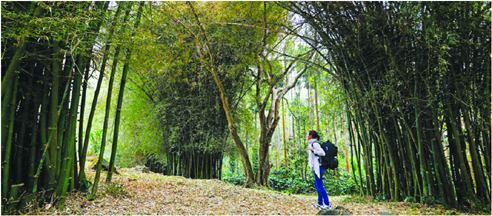
Popularly known as the ‘Coffee Land of Karnataka’, Chikmagalur is situated in the foothills of the Mullayangiri Range and is one of the most beautiful hill stations in Karnataka. Chikmagalur has a perpetual fragrance of coffee lingering in the air with it plenty of coffee plantations. Famous for its tall mountains, lush green forests and its tranquil environment (apart from its coffee production), Chikmagalur is a very popular tourist destination and is a quick retreat for the people of Karnataka.
COFFEE CULTURE
Perfect for a traveller who is happy sauntering between the thick undergrowth of the wild coffee bushes, eyes peeled for exotic birdlife and animals, Chikamagalur is the ideal pick. Most of the accommodations lie in the backdrop of coffee plantations, giving the traveller an opportunity to stay in the middle of a million shades of green. Coffee plantation walks organised by the owners are an essential orientation to understand the variety, seasons, wildlife around the area, history of coffee making, processes and what a planter’s life might be like. Coffee plantations of Chikmagalur offer a brilliant atmosphere for both outdoor junkies and those who like to switch off and do nothing. Outdoor enthusiasts during their short hikes to the top of a plantation often make their way through forest streams and spot an array of local avian and animal occupants.
Birding enthusiasts should remember to carry their binoculars. For those who need to unwind without a packed itinerary or an activity should grab a book or an i-pod and sink into a lounging chair or a hammock, and succumb to the sound of nature around. Miles of stunning views, ludicrous amount of green and the whiff of coffee accompany the copious amount of mugs you can down.
MOUNTAIN CIRCUIT
The main highlight of Chikmagalur for most travellers lies in covering the three main peaks of the town?Sheethalagiri, Baba Budan Giri and Mullayanagiri. Head towards Kaimara junction to start at the foothills of this loop and head first towards Sheethalagiri. This is an ancient temple whose history can be traced back to 1000 years and is dedicated to Mallikarjuna Swamy. The temple itself is not very elaborate but is worth your while for its history and the ‘prasadam’, a fistful of water from a natural trickle of waterfall inside. Next on the same route is Baba Budan Giri hill, also known as Dattagiri Hill Range or Inam Dattatreya Peetha after the famous saint who brought coffee to India. This small shrine is propped at 1895 m offering a breathtaking view of the valley below. The shrine is visited by people of all religions. The next stop is Mullayanagiri, the highest peak (1930 m) in the state of Karnataka. Predictably windy and bone chilling cold, it’s apt to stay for a short time to enjoy the view. Many trekkers take on the mammoth mountain despite the winds and near invisible paths due to the mist. The trio are known as the Chandradrona Parvatha Shreni.
KEMMANAGUNDI
Even though Kemmanagundi lies almost 500 m below the highest Karnataka peak, Mullayanagiri, the views from here are equally riveting as the hills cascade down, draped in coffee bushes. It is more accessible than the higher mountain loop and is embellished by pit stops for tourists; an unimpressive rock garden and a government run children’s park are part of Kemmanagundi area but can be avoided. This does not hamper dozens of camera happy tourists enjoying the lush green environs as a backdrop to perfect pictures. What is not to miss is the few spots from where you can see the clouds fill up the valley for a mesmerising view. This was the very reason King Krishnaraja Wodeyar IV chose this as a summer retreat. There are a handful of restaurants, viewing decks and even a place to stay maintained by the Karnataka State Tourism Development Board. Raj Bhavan is one of the most popular viewing points of the hill top. If you’re running short of time, stick with the Sheethalagiri-Baba Budan Giri- Mullayanagiri circuit and give this one a miss. The only veritable reason why one should visit Kemmanagundi, is because it is the only access point to Hebbe Falls. Local four wheel jeeps can be hired from here to get to the beautiful untouched waterfalls.
HEBBE FALLS
Adventure lovers are promised a bone rattling yet thrilling drive of 13 km, through forested paths (sometimes no paths at all) from Kemmanagundi to Hebbe Falls. A four wheel experience is the only way to manoeuvre through the bumpy road. There are local jeeps available at the base of Kemmanagundi that charge anywhere around Rs 300-500 for a return trip on a sharing basis. After the 13 km ride, one has to reach the falls on foot, after crossing two shallow streams. The effort is absolutely worth your while as you watch the 551 ft drop from the base. There are two stages of the waterfall: Dodda Hebbe (Big Falls) and Chikka Hebbe (Small Falls). The white frothy water cascades down with gusto but even though it looks tempting to go stand under it, it is not recommended. The falls are slightly cut off and isolated. It is likely that no medical help can reach soon. It is recommended to remain at its fringes. This is most voluminous after or during monsoons, but this also means that the area is likely to be infested with swift leeches. Carry a small packet of salt to get rid of them soon.
KALHATTI FALLS
Given that Chikmagalur has a large forest cover and entire hillsides covered with plantations, it is not uncommon to see many small and big waterfalls and rivulets around the area. One of the most popular amongst the religious travellers is the Kalhatti waterfall, even though it is far smaller than the nearby Hebbe Falls. From Kemmanagundi, the drive to Kalhatti is only 10 km. The spot can be recognised with a swathe of people, buses and cars on the main road itself. Stop here, and walk a short distance to the base of the falls. Even though it does not match up to the impression of Hebbe Falls, it makes for a great stop for those who like to tick things of the list when visiting a destination. A temple of Lord Veerabhadra stands at the base of the 122 me drop. The falls are also known as the Kalahasti falls by the locals. There are a few local shops here where one can stop for a quick snack. The waterfall lies on the same loop of Mullayangiri, Baba Budan Giri and Seethalagiri hills along with Kemmanagundi. It is easy to pack this in one day of sightseeing, in the same direction.





Be the first to comment